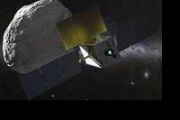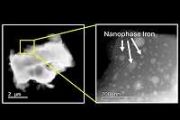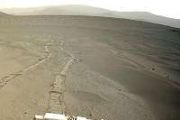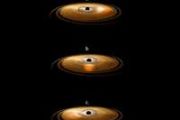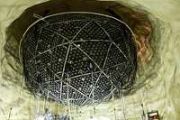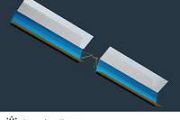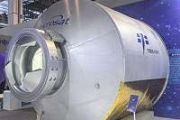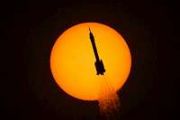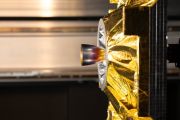
Copernical Team
Unistellar and SETI Institute expand Worldwide Citizen-Science Astronomy Network
 The number of citizen scientists surveying the night sky is about to soar, thanks to grants by the Lounsbery Foundation and the Gordon and Betty Moore Foundation to Unistellar and the SETI Institute.
A pioneer of New Astronomy, Unistellar is the company behind a new category of telescopes, the eVscopes, the world's most powerful and simple-to-operate smart telescopes. In just a few years,
The number of citizen scientists surveying the night sky is about to soar, thanks to grants by the Lounsbery Foundation and the Gordon and Betty Moore Foundation to Unistellar and the SETI Institute.
A pioneer of New Astronomy, Unistellar is the company behind a new category of telescopes, the eVscopes, the world's most powerful and simple-to-operate smart telescopes. In just a few years, Upper Stage Propulsion System for future Artemis mission reaches major milestone
 While the Artemis I team prepares for its upcoming mission, NASA and contractor teams are already building rockets to support future Artemis Moon missions. In United Launch Alliance's (ULA) factory in Decatur, Alabama, major components have been completed for the Artemis III interim cryogenic propulsion stage (ICPS) that will provide the power to send astronauts to the Moon.
The ICPS, whic
While the Artemis I team prepares for its upcoming mission, NASA and contractor teams are already building rockets to support future Artemis Moon missions. In United Launch Alliance's (ULA) factory in Decatur, Alabama, major components have been completed for the Artemis III interim cryogenic propulsion stage (ICPS) that will provide the power to send astronauts to the Moon.
The ICPS, whic Dutch researchers teleport quantum information across rudimentary quantum network
 Researchers in Delft have succeeded in teleporting quantum information across a rudimentary network. This first of its kind is an important step towards a future quantum Internet. This breakthrough was made possible by a greatly improved quantum memory and enhanced quality of the quantum links between the three nodes of the network. The researchers, working at QuTech-a collaboration between Delf
Researchers in Delft have succeeded in teleporting quantum information across a rudimentary network. This first of its kind is an important step towards a future quantum Internet. This breakthrough was made possible by a greatly improved quantum memory and enhanced quality of the quantum links between the three nodes of the network. The researchers, working at QuTech-a collaboration between Delf Fleet Space reports launch of Centauri 5 satellite
 Fleet Space Technologies announces today that it successfully launched its next-generation Centauri 5 satellite on the Space X Falcon 9 Transporter-5 mission. The launch took place at 03:57AM ACST.
This was the company's third launch with SpaceX, following the successful deployment of Centauri 4 on the Transporter-2 mission in June 2021.
Centauri 5 will be placed in low earth orbit (
Fleet Space Technologies announces today that it successfully launched its next-generation Centauri 5 satellite on the Space X Falcon 9 Transporter-5 mission. The launch took place at 03:57AM ACST.
This was the company's third launch with SpaceX, following the successful deployment of Centauri 4 on the Transporter-2 mission in June 2021.
Centauri 5 will be placed in low earth orbit ( ICEYE completes its largest satellite launch ever with SpaceX
 ICEYE, the global leader in persistent monitoring with radar satellite imaging and an expert in flood and natural catastrophe (NatCat) solutions, has successfully launched five new SAR satellites. All spacecraft were launched on SpaceX's Falcon 9 smallsat rideshare mission via EXOLAUNCH from Cape Canaveral, Florida.
Communication has successfully been established with each spacecraft. ICEY
ICEYE, the global leader in persistent monitoring with radar satellite imaging and an expert in flood and natural catastrophe (NatCat) solutions, has successfully launched five new SAR satellites. All spacecraft were launched on SpaceX's Falcon 9 smallsat rideshare mission via EXOLAUNCH from Cape Canaveral, Florida.
Communication has successfully been established with each spacecraft. ICEY NRO awards Maxar 10-year deal under the Electro-Optical Commercial Layer Acquisition program
 Maxar Technologies (NYSE:MAXR) reports it has been awarded an Electro-Optical Commercial Layer (EOCL) contract by the U.S. National Reconnaissance Office (NRO). EOCL, a five-year base contract with five additional years of options through 2032, represents the largest ever commercial imagery acquisition contract awarded by the NRO.
Under the award agreement, Maxar will continue to provide h
Maxar Technologies (NYSE:MAXR) reports it has been awarded an Electro-Optical Commercial Layer (EOCL) contract by the U.S. National Reconnaissance Office (NRO). EOCL, a five-year base contract with five additional years of options through 2032, represents the largest ever commercial imagery acquisition contract awarded by the NRO.
Under the award agreement, Maxar will continue to provide h Momentus Launches First Demonstration Flight on SpaceX Falcon 9
 Momentus Inc. (NASDAQ: MNTS) has launched its first demonstration flight of the Vigoride orbital transfer vehicle to low-earth orbit aboard the SpaceX Transporter-5 mission. Momentus also announced that it has placed its first customer satellite in orbit and plans to conduct more deployments of customer payloads in the coming days.
The versatile Vigoride spacecraft, designed to support a r
Momentus Inc. (NASDAQ: MNTS) has launched its first demonstration flight of the Vigoride orbital transfer vehicle to low-earth orbit aboard the SpaceX Transporter-5 mission. Momentus also announced that it has placed its first customer satellite in orbit and plans to conduct more deployments of customer payloads in the coming days.
The versatile Vigoride spacecraft, designed to support a r US Govt awards Planet EOCL contract
 Planet Labs PBC (NYSE: PL), a leading provider of daily data and insights about Earth, today announced that the National Reconnaissance Office (NRO) has selected Planet Labs Federal, Inc. (Planet Federal), Planet's wholly owned subsidiary, for an award to the Electro-Optical Commercial Layer (EOCL) contract.
EOCL is the U.S. government's industry-defining procurement vehicle for unclassifi
Planet Labs PBC (NYSE: PL), a leading provider of daily data and insights about Earth, today announced that the National Reconnaissance Office (NRO) has selected Planet Labs Federal, Inc. (Planet Federal), Planet's wholly owned subsidiary, for an award to the Electro-Optical Commercial Layer (EOCL) contract.
EOCL is the U.S. government's industry-defining procurement vehicle for unclassifi Spaceflight Inc. debuts its latest OTV, Sherpa-AC
 Spaceflight Inc., the leading global launch services provider, today announced it has contacted its Sherpa-AC vehicle and confirmed the vehicle is operating nominally. This is the debut launch of Sherpa-AC, the latest variation in the company's Sherpa orbital transfer vehicle (OTV) portfolio.
The Transporter 5 rideshare mission on board a SpaceX Falcon 9 lifted off from Cape Canaveral on M
Spaceflight Inc., the leading global launch services provider, today announced it has contacted its Sherpa-AC vehicle and confirmed the vehicle is operating nominally. This is the debut launch of Sherpa-AC, the latest variation in the company's Sherpa orbital transfer vehicle (OTV) portfolio.
The Transporter 5 rideshare mission on board a SpaceX Falcon 9 lifted off from Cape Canaveral on M LeoLabs to support Japan Air Self Defense Force with Commercial Space Domain Awareness
 LeoLabs, Inc., the world's leading commercial provider of low Earth orbit (LEO) mapping and Space Situational Awareness (SSA) services, has announced a multimillion-dollar award to provide data and services for the Japan Air Self Defense Force (JASDF). The agreement offers Japan access to the largest set of actionable insights in existence for tracking satellites and orbital debris in low Earth
LeoLabs, Inc., the world's leading commercial provider of low Earth orbit (LEO) mapping and Space Situational Awareness (SSA) services, has announced a multimillion-dollar award to provide data and services for the Japan Air Self Defense Force (JASDF). The agreement offers Japan access to the largest set of actionable insights in existence for tracking satellites and orbital debris in low Earth 
